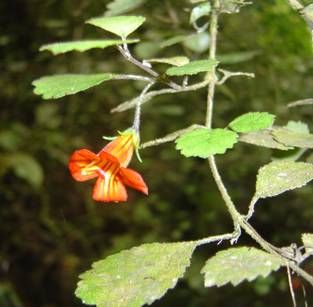Anderson et al. studied three species of birds known to pollinate the shrub Rhabdothamnus solandri. They compared shrub populations at sites on the North Island of New Zealand, where the birds are functionally extinct, to populations at sites on three nearby islands, where the birds remain abundant. Combining field studies with experiments, the authors showed that functional extinction of the birds limited pollination of the shrub, reducing seed production by 84% and reducing the number of juvenile plants produced per adult by 55%.
Source:
Cagan H. Sekercioglu. Functional Extinctions of Bird Pollinators Cause Plant Declines
SCIENCE VOL 331 25 FEBRUARY 2011, 1019-1020
http://xa.yimg.com/kq/groups/17598545/1620006717/name/Bird+pollination+…
Article by Anderson et al.:
http://www.sciencemag.org/content/331/6020/1068.short
In their latest study, published in the journal Science, Anderson and Kelly, who are based at the universities of Auckland and Canterbury, respectively, linked the 19th-century extirpation from the upper North Island of two bird species—the bellbird (Anthornis melanura) and stitchbird (Notiomystis cincta)—with reductions in pollination of a shrub known as Rhabdothamnus solandri. A third pollinating bird—the tui (Prosthemadera novaeseelandiae)—survives in reduced numbers on the upper North Island but rarely visits flowers.
Anderson and Kelly’s work has described, for the first time, a terrestrial trophic cascade in the North Island that has fundamentally altered local ecology. Trophic cascades often begin with the introduction of a predator, which causes shifts in ecosystem structure and function, typically with consequent losses in biodiversity.
Anderson and Kelly’s investigation of pollination of Rhabdothamnus followed from earlier research by biologist Jenny Ladley, a co-author on the Rhabdothamnus work, who in the early 1990s showed that mistletoes (Peraxilla species) were suffering from low natural pollination by birds at many mainland (North and South Island) sites. “So, we started testing other New Zealand plants with bird-adapted flowers,” Kelly said.
Because Rhabdothamnus grows both on the North Island, where its pollination is limited, and on offshore islands, where its pollination thrives, it represented an ideal subject for investigating the consequences of bird declines. That birds might be a key factor was made apparent by Anderson’s observations of bird-pollinated plants. As she explained, “From fieldwork on offshore islands, I knew there was a whole suite of native flowering plants receiving bird visitation. But on the adjacent mainland, these same plants were rarely visited by birds.”
When Anderson and Kelly began their research, very little was known about Rhabdothamnus. In fact, it was not even clear whether the shrub was pollinated by birds or by insects. “As far back as 1902, botanist Donald Petrie was puzzling over what pollinated Rhabdothamnus,” Anderson noted.
After a meticulous exploration of the effects on pollination of bird exclusion from flowers, the team successfully identified the shrub’s primary pollinators—the bellbird, stitchbird, and tui. According to Kelly, “The two key birds (bellbirds and stitchbirds) that were lost off the North Island, and that were vital for Rhabdothamnus pollination, were lost very rapidly about 1870.”
Read more:
http://www.britannica.com/blogs/2011/03/science-front-sandra-anderson-d…

- Login om te reageren
